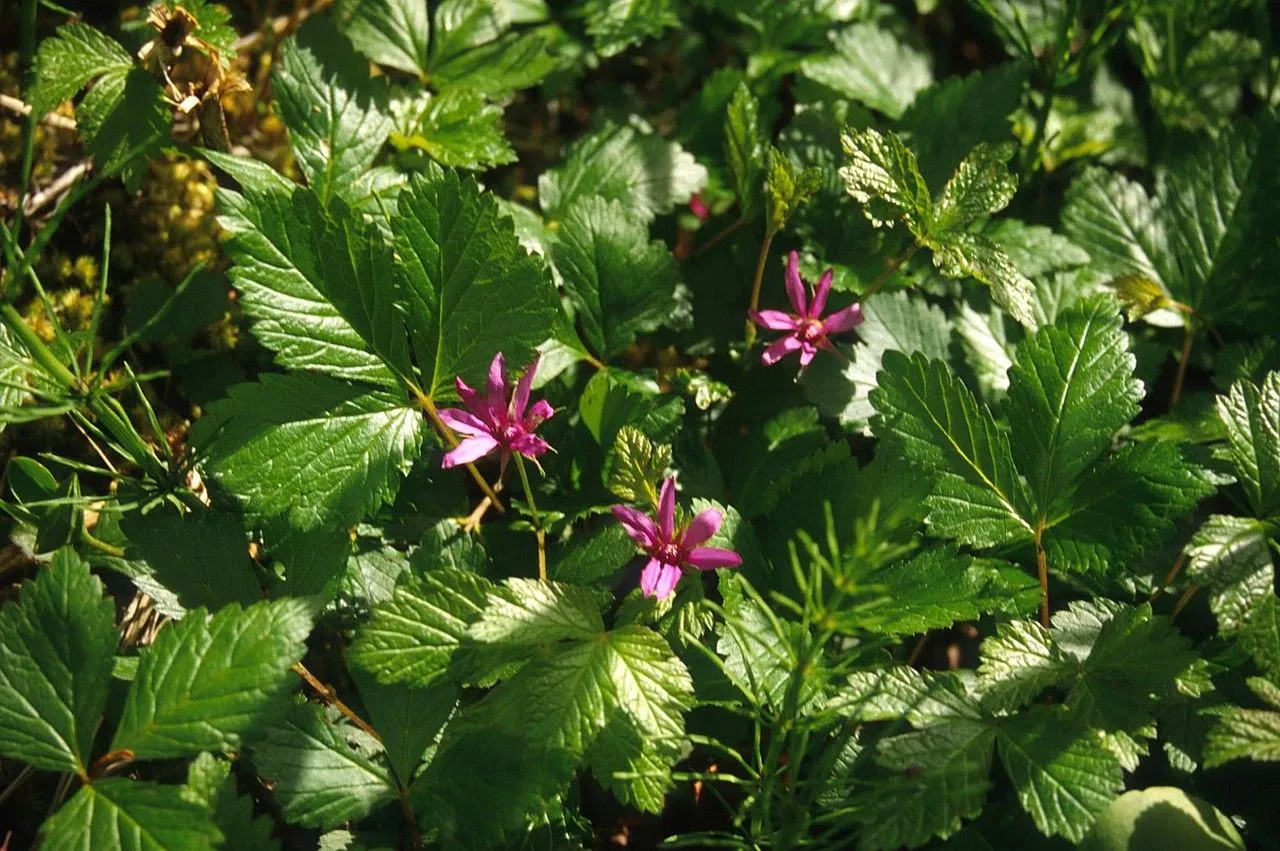
Author: L.
Bibliography: Sp. Pl.: 494 (1753)
Year: 1753
Status: accepted
Rank: species
Genus: Rubus
Vegetable: False
Observations: Subarctic to NW. U.S.A. and N. Japan
Arctic bramble, known scientifically as Rubus arcticus, is a fascinating species of flowering plant that belongs to the Rosaceae family. Described by the renowned botanist Carl Linnaeus in his seminal work “Species Plantarum” in 1753, this plant has since captivated botanists and enthusiasts alike with its unique adaptations and geographical range.
Native to subarctic regions, the Arctic bramble is found stretching across the northernmost parts of the United States and extending into northern Japan. These regions are characterized by harsh climates where adaptability is key for survival. Despite these challenging conditions, the Arctic bramble thrives, showcasing the remarkable resilience of flora in extreme environments.
Rubus arcticus is a low-growing perennial that typically reaches heights of 10 to 25 centimeters. It is well known for its small, yet exquisite flowers, which are usually deep pink or red. The blooms herald the arrival of summer, adding a splash of color to the often stark and rugged landscapes where they grow. Following the flowering period, the plant produces small, aggregate fruits that are highly cherished. These berries are not only a delight to the eyes but are also edible, offering a burst of flavor that is both sweet and tart. They are often used in jams, jellies, and desserts, prized for their unique taste and nutritional value.
The leaves of the Arctic bramble are trifoliate, meaning each leaf is divided into three smaller leaflets. This distinctive foliage, combined with its charming berries and flowers, makes it a plant of considerable horticultural interest. Beyond its aesthetic and culinary allure, Rubus arcticus also plays a vital role in its ecosystem. It provides essential sustenance for various wildlife species, ranging from insects to birds and mammals, all of which depend on its fruits and foliage for nourishment.
Due to its specific habitat requirements and relatively limited distribution, the Arctic bramble can serve as an indicator species for the health of subarctic ecosystems. As climate change continues to impact these delicate environments, studying the growth patterns and abundance of Rubus arcticus offers valuable insights into broader ecological changes.
In summary, the Arctic bramble (Rubus arcticus) is more than just a plant; it is a symbol of resilience and adaptability. Its presence across subarctic to northwestern U.S.A. and northern Japan underscores the interconnectedness of global flora and highlights the importance of conserving these unique habitats. Whether admired for its beauty, harvested for its berries, or studied for its ecological significance, the Arctic bramble is a botanical treasure.
Eng: arctic bramble, arctic raspberry, arctic blackberry, nagoonberry
Dan: bjørnebær
Nor: aakerbær
Fin: mesimarja
Swe: mesimarja, åkerbär
Lav: ziemelu kaulene
Nob: åkerbær
Nno: åkerbær
Fra: ronce arctique
Sme: váđot, geađgeluomi, miehtamuorji
Cym: llwyn mwyar yr arctig, llwyni mwyar yr arctig
En: Arctic bramble, Arctic raspberry, Arctic blackberry, Northern Blackberry, Gïeken-muerjie, Mietâmyerji, Miõttmueʹrjj, Vijnnamuorjje, Nagoonberry
Be: Касцяніцы арктычныя
Zh: Bei xuan gou zi, 北悬钩子
Cs: Ostružiník arktický
Da: Bjørnebær
Et: Soomurakas
Fi: Mesimarja
Fr: Ronce arctique
Ka: Არქტიკული მაყვალი
De: Allackerbeere
Ko: 함경딸기
Lv: Ziemelu kaulene
Lt: Šiaurinė katuogė
Se: Váđot, Geađgeluomi, Miehtamuorji
No: Åkerbær, Aakerbær
Nb: Åkerbær
Nn: Åkerbær
Fa: تمشک قطبی
Pl: Malina tekszla
Ru: Княженика обыкновенная
Sv: Åkerbär, Mesimarja
Zh-tw: 北懸鉤子
Zh-hant: 北懸鉤子
Cy: Llwyn mwyar yr Arctig, Llwyni Mwyar yr Arctig
Taken Aug 4, 2022 by #MaryKingfishers MK (cc-by-sa)
Taken May 25, 2022 by Carolyn Friday (cc-by-sa)
Taken May 25, 2022 by Carolyn Friday (cc-by-sa)
Taken Jun 18, 2022 by Bela Borbely (cc-by-sa)
Taken Aug 4, 2022 by #MaryKingfishers MK (cc-by-sa)
Taken May 14, 2022 by Timur Delahaye (cc-by-sa)
Taken Aug 20, 2021 by Silvestre Ricardo (cc-by-sa)
Taken Jun 7, 2021 by Laureen Kosheiff (cc-by-sa)
Taken Aug 4, 2019 by natalieel natalieel (cc-by-sa)
Taken Jun 18, 2022 by Bela Borbely (cc-by-sa)
Taken Jun 9, 2022 by Joëlle rousseau (cc-by-sa)
Taken Jul 15, 2022 by Sara lynch (cc-by-sa)
Taken Jul 12, 2022 by runningsalami (cc-by-sa)
Taken Aug 4, 2019 by natalieel natalieel (cc-by-sa)
Taken Aug 13, 2020 by dana mountifield (cc-by-sa)
Taken Jul 30, 2020 by Marilyse Goulet (cc-by-sa)
Taken Jul 23, 2019 by Ryan (cc-by-sa)
Taken Jan 1, 1900 by EOL − Smithsonian Institution, National Museum of Natural History, Department of Botany (cc-by-nc-sa)
Taken Jan 1, 1900 by EOL − Smithsonian Institution, National Museum of Natural History, Department of Botany (cc-by-nc-sa)
Taken Jan 1, 1900 by EOL − Smithsonian Institution, National Museum of Natural History, Department of Botany (cc-by-nc-sa)
© copyright of the Board of Trustees of the Royal Botanic Gardens, Kew.
© copyright of the Board of Trustees of the Royal Botanic Gardens, Kew.
© copyright of the Board of Trustees of the Royal Botanic Gardens, Kew.
Growth form: Rhizomatous
Growth habit: Subshrub, Forb/herb
Growth rate: Moderate
Ph maximum: 7.0
Ph minimum: 5.0
Family: Myrtaceae Author: (F.Muell.) K.D.Hill & L.A.S.Johnson Bibliography: Telopea 6: 402 (1995) Year: 1995 Status:…
Family: Rubiaceae Author: Pierre ex A.Froehner Bibliography: Notizbl. Bot. Gart. Berlin-Dahlem 1: 237 (1897) Year:…
Family: Sapindaceae Author: Koidz. Bibliography: J. Coll. Sci. Imp. Univ. Tokyo 32(1): 38 (1911) Year:…
Family: Asteraceae Author: A.Gray Bibliography: Pacif. Railr. Rep.: 107 (1857) Year: 1857 Status: accepted Rank:…
Family: Fabaceae Author: Medik. Bibliography: Vorles. Churpfälz. Phys.-Ökon. Ges. 2: 398 (1787) Year: 1787 Status:…
Family: Aspleniaceae Author: (Cav.) Alston Bibliography: Bull. Misc. Inform. Kew 1932: 309 (1932) Year: 1932…